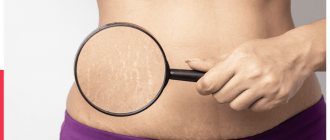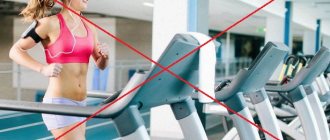Features of the female physique
Many women associate the dream of a perfectly flat stomach with total weight loss. And they even begin their path to the ideal, practicing all kinds of methods for regulating body weight. The kilograms are gradually decreasing and the weight seems to be normal, but the figure still remains imperfect - the stomach does not become flat and the waist is thin. Quite natural questions arise: what is this connected with, and how to proceed?
The fact is that even with normal weight, fat deposits can be distributed unevenly. So, some thin-looking women have a fairly significant layer of fat on the abdomen, buttocks and thighs. That is why for a good figure it is not so much the ratio of weight and height that is important, but the size of the fat layer.
The normal level for a healthy woman is considered to be 23-24% fat, with 10-12% of it accumulating in the chest, buttocks, and inner thighs (trained female athletes, as a rule, have only 10-15% fat).
It is believed that it is difficult for an adult woman to achieve a figure below 17%, moreover, reducing body fat below 13% can significantly harm health.
During pregnancy, as a result of hormonal changes in the body, the fat layer increases. It must protect the fetus from external influences. This is especially true for the abdomen, so after childbirth, in addition to stretched muscles, which should return to normal over time, there remains a layer of fat on the abdomen. Because of this, it protrudes, looks uneven and ugly.
What can be done in such a situation? It is necessary to reduce the percentage of fat, while simultaneously increasing the strength of the abdominal muscles, giving them the desired shape.
In what cases is a bandage after childbirth contraindicated?
It happens that the doctor prohibits wearing a bandage, as well as any shapewear. The thing is that such pads and belts can only aggravate the course of the disease. Contraindications for wearing a bandage are as follows:
- seams in the crotch area;
- kidney disease;
- gastrointestinal diseases;
- allergic reactions to bandage fabric;
- skin diseases.
In these situations, the bandage will only do harm. Often, many mothers who have tried a bandage and encountered negative manifestations consider the bandage to be the source of all problems, although in fact the problem is hidden in various diseases. If you fully comply with all medical indications, then no negative manifestations will arise when wearing a bandage.
Working the abdominal muscles
The shape of the abdomen depends on the thickness of the fat layer and the condition of the abdominal wall muscles. The normal condition is when the abdominal wall protrudes just a little and the stomach remains flat. Weakness of this muscle group leads to the formation of a protruding or saggy abdomen. Physical exercises to work the abdominal muscles, which are divided into four types, will help increase their tone:
- Leg work with a stationary torso - raising and lowering, bending and straightening, cross, circular movements, etc. These movements strengthen the lower abdominal muscles.
- The work of the body with motionless legs is raising, lowering, turning the body, etc. In this way, the upper abdominal muscles are strengthened.
- Simultaneous work of the torso and legs - most of the abdominal muscles are usually included in the movement.
- Cross work with the torso and legs. In this case, the oblique abdominal muscles, which form the lateral muscular walls of the abdominal cavity, receive the load.
When doing exercises, you need to remember that the abdominal muscles are attached to the lower edges of the ribs on one side, and to the pelvis on the other. Therefore, when you lift your legs, you need to lift your pelvis. When performing complexes lying on your back and raising your knees to your stomach, do not be lazy to lift your pelvis from the floor, bringing your knees closer to your forehead.
While hanging on a bar or wall bars, you also need to pull your knees to your chest, lifting your pelvis.
Weakening of the anterior abdominal wall
Externally, the contraction of the skin occurs quite quickly, and already 2-3 weeks after birth the stomach has practically “fallen into place.” But inside there are muscles that have lost the habit of working for at least 4-5 months. And then diastasis, that is, the separation of the rectus abdominis muscles, can become a serious problem.
What will happen if you do not eliminate:
- Violation of the aesthetic appearance of the abdomen
- Weakening support for internal organs
- Umbilical hernia
- Back pain
How it manifests itself:
- Uneven protrusions in the abdomen, changing its correct shape, which do not retract when the press is tense
- Flabbiness of the abdomen
- Feeling of heaviness after eating, belching
Solution:
Exercises. Retraction of the abdomen, straight twisting, but oblique twisting and circular movements in the waist area should be avoided - this aggravates the divergence of the muscles.
Biostimulation using the Futura Pro device. A unique device that performs more than 150 thousand programs by generating natural electrical impulses, ultrasound, microcurrent therapy and influencing acupuncture points. Unlike physical activity, it does not affect lactation and can actively affect the oblique muscles without increasing diastasis. In terms of load intensity, 1 session corresponds to 40 minutes of high-intensity aerobic training; very effectively tightens muscles and heals cells in the affected area.
When can you start exercising after giving birth?
It is especially worth drawing the attention of women to the fact that you can start strengthening your abdominal muscles after a natural birth only after 6-8 weeks, after a cesarean section - after 2-2.5 months. If you put stress on the abdomen at an earlier stage, you can expect serious troubles: sutures coming apart (for example, after a cesarean section or after suturing the perineum when it ruptures), increased intra-abdominal pressure and prolapse of the vaginal walls. Therefore, do not rush into physical activity, and during the recovery period, pay attention to your diet, excluding particularly high-calorie foods. But do not follow a strict diet - this is contraindicated for a nursing mother, because a deficiency of nutrients will immediately affect the quality of milk and well-being. It is better to observe the well-known reasonable restrictions on sweets, fatty and fried foods.
Stretching of the muscles and vaginal mucosa
Childbirth is always a traumatic factor for the vagina. Even if it is the most correct and natural, the tissues still experience enormous stress and stretch so much that they “come to their senses” only after 2-3 months. In this case, the prenatal state is never achieved.
What will happen if you do not eliminate:
- Decreased sensitivity during sex
- Disappearance of orgasm
- Development of stress urinary incontinence
- Persistent candidiasis (thrush)
- If you do not pay attention to “this place” immediately after the first birth, then the birth of the next child greatly aggravates the pathological condition of the vagina, up to its prolapse and prolapse during menopause
How it manifests itself:
- Air exposure during sports
- Squelching sounds during sex
- Urine splashing
Solution:
Vaginal gymnastics. Suitable for young women (up to 30 years old) with uncomplicated first birth; requires discipline; With regular exercise for 6 months, the effect is good.
Laser correction using the Fotona device, the only laser in the world with a gynecological attachment. A painless and quick procedure that allows you to eliminate the problem in 1-3 sessions (depending on the severity of the sprain). Laser radiation evenly heats the deep layers of the vagina, which leads to a significant lifting effect, without damaging the surface layer.
Vaginal threads. A modern and fast way to eliminate severe sagging fabrics. The procedure is performed under local anesthesia in 30 minutes and involves the introduction of special biothreads under the mucosa, creating good support.
Vaginal fillers. They quickly and plastically change the anatomy in the injection area. The filling of fabrics can be adjusted during execution. The effect is already after 1 procedure; the result is easily corrected; create good filling, quickly restore sensitivity during sex.
It is necessary to restore vaginal tissue after any childbirth, even in the absence of symptoms. Choose any method for yourself, the main thing is don’t start it. The best option would be to combine gymnastics with modern and very effective methods, which are presented in Neo Vita in full and combine perfectly with each other.
Exercises for a flat stomach
So, you have recovered from childbirth and are ready to develop a flat stomach. How and where is the best place to study? There are no uniform rules and recommendations for working on your own body. There are different methods from which you need to choose the one that suits you, or combine several methods at once.
Shaping
The goal of shaping is to improve your figure through exercises that borrow the best from aerobics and athletic gymnastics. Fans of such activities are often called sculptors of their bodies. This comparison accurately captures the essence of the workout - targeted impact on various muscle groups, so in addition to the abdomen, the muscles of the back, arms and legs are strengthened.
Shaping classes are held in sports clubs, where groups are recruited for classes at different times under the guidance of an instructor.
For a young mother, this option has its pros and cons. On the one hand, regular classes at the club will allow her to work on her figure at least twice a week for 40-50 minutes. On the other hand, the same lack of time and various unforeseen circumstances may prevent you from regularly attending these training sessions, so another option may be preferable for you.
Home exercise set
There are specially designed sets of simple exercises, performing which you can achieve good results, in particular, a flat stomach. At the same time, when performing any exercise, you must firmly know what, why and how to do it. Therefore, we offer some tips and recommendations:
- Before performing a set of exercises, do a short warm-up. This could be jumping rope, dancing to music, etc.
- Don't use weights. They form voluminous muscles, and voluminous abs are unlikely to be your goal.
- During exercises, keep your abs in constant tension. Pay close attention to your technique. The result will be better if you do the exercise 20 times correctly than 50 times, but carelessly.
- Train intensely. Some trainers advise sparing yourself, assuring that you can exercise half-heartedly. Of course, you can if you train for fun, but if you want to get results, you need to give it your all.
If you have never exercised before or are starting to exercise after a long break, start exercising gradually, with one approach (the recommended number of times you should do the exercise without a break), and gradually increase to four.
Watch your breath! As you exhale, tighten your abdominal muscles and pull the front wall of your abdomen into you as deeply as possible, while simultaneously relaxing your ribs so that they drop down. When you inhale, try not to relax your abdominal muscles. The abdominal wall should remain retracted. The abdomen swells mainly to the sides and upwards.
The abs should be trained at least three times a week, maximum every day.
As practice has shown, the best method of training the abs is a giant set, when several exercises are done one after another, without stopping. After each giant set, you can rest for one minute. It is recommended to perform the exercises at a fast pace and with the maximum number of repetitions. At the end of this “marathon” your abs should just be burning. But you need to approach a giant set gradually , gradually increasing the intensity of your workouts.
When performing exercises, you must constantly concentrate on your sensations, on the state of your abdomen, the muscles of which should tense.
Do not eat 1 hour before or after exercise.
Before performing the exercises, you need to stretch your muscles:
- Stretching 1. Inhale - round your stomach as much as possible. Exhale - the front wall of the abdomen moves towards the spine. Hold this position for a few seconds. Do 4-5 sets of 10 reps.
- Stretch 2: Lie on your stomach. Bend back as much as possible and fix yourself in this position for a few seconds. Do 4-5 sets of 10 times.
Now you can start the exercises.
Exercise 1
Starting position: legs together. When squatting, push your buttocks back strongly, tilt your body and place your hands on the middle of your thighs. Inhale and round your stomach, inflating it like a balloon.
Straightening up, raise your arms up and spread them in the Latin letter V. At the same time, you need to straighten your back as much as possible, exhale and draw in your stomach. This is the so-called “belly breathing.” With an exhalation, we draw in the front wall of the abdomen.
Then we inhale slowly through the nose, relaxing the diaphragm. The stomach protrudes forward. At the same time, the lower abdomen fills with air.
Exhalation - the front wall of the abdomen is drawn inward as much as possible, forcing air to exit through the nose.
When breathing with the stomach, only the lower part of the lungs is filled with air and the stomach performs a wave-like movement. The chest remains motionless. Perform 16 times.
Attention! Don't lift your heels off the floor and be sure to watch your breathing!
When performing this exercise, you need to feel the movement of the front wall of the abdomen towards the spine when breathing, which is the main point of this exercise.
Exercise 2
Starting position: lying on your back, hands clasped behind your head.
As you exhale, raise your shoulder blades and bend your legs, pull your knees to your chest and your heels to your buttocks. Be sure to suck in your stomach.
Then, spread your legs - straighten the left one, but leave it hanging, and pull the knee of the right leg towards the opposite elbow. When changing legs in a semicircle, take a short breath, but again, concentrate on exhaling and touching your elbow to your knee.
The exercise is performed as long as there is enough strength.
Exercise 3
Starting position: lie on your side, legs slightly bent. Place your shoulder on the floor slightly in front of you.
If you are lying on your left side, slightly “twist” your body around its own axis to the right. On the count of “one”, stretch your hands to your heels, while tearing off your knees and shoulder blades. Hold the pose for 30 seconds to a minute.
Next, stretch the obliques, which form the sides of your abdominal cavity, by throwing your knees to one side and your arms to the other, thus twisting your torso in the opposite direction.
Repeat the entire sequence of exercises in the starting position lying on your right side.
Exercise 4
Starting position: lying on your back, legs slightly bent and shoulder-width apart. Hands along the body, lower back pressed to the floor.
As you exhale, pull your stomach in as much as possible and lift your pelvis as much as possible towards the ceiling. Having reached the highest point, hold the pose for 30 seconds.
Engage your oblique muscles by straightening one leg and then the other for 15 seconds.
When performing these movements, try to eliminate the work of the buttocks as much as possible.
Exercise 5
Starting position: lie on your back, pull your knees to your chest. Spread your arms to the side, pressing your palms to the floor.
On the count of “one,” lift your buttocks slightly and move your hips to the side, keeping your knees together. Don't put your knees on the floor! Breathe evenly and do not lift your shoulders off the floor.
Return to the starting position and repeat the exercise in the other direction.
Exercise 6
Starting position: lying on your back, hands behind your head, legs bent, feet on the floor.
Stretch your arms forward, lift your shoulders off the floor. Inhale while lying down, exhale while sitting. You can make this exercise more difficult by holding this position.
The main mistake with this exercise is tensing your neck muscles instead of your abdominal muscles, so try not to move your head back and forth.
Exercise 7
Starting position: lying on your back, arms along your body, legs raised and bent at the knees (or straightened up, as a more difficult option).
Raise your pelvis as if you were going to do a shoulder stand, but not too high. Your hands remain on the floor, but you need to lean on them as little as possible.
The main mistake is swinging your legs to create momentum. It is necessary to lift the pelvis only using the abdominal muscles.
Exercise 8
Performed on a bed or bench.
Starting position: sit on the edge of the bed, then lie on your back, hands behind your head. Pull your legs bent at the knees towards your stomach.
Then straighten your legs so that your body is stretched into a string. Then pull your legs back up. The knees can be spread apart.
This exercise works the lower abs well.
How to remove belly fat after childbirth
Surely, you are interested in the question of how to remove belly fat after childbirth; you can see photos after tummy tuck surgery here.
2) You have a divergence of the rectus abdominis muscles. It occurs when there is no fusion of the aponeurosis (fascia covering the rectus abdominis muscles on each side) of the rectus abdominis muscles in the midline. Determining the discrepancy of the rectus abdominis muscles is simple. To do this, you need to lie on your back and raise your head. If a depression forms in the center of the abdomen - a path - it definitely exists. As a rule, the discrepancy of the rectus abdominis muscles is present from birth, but it may not be noticeable. After pregnancy, it always intensifies and as a result, the stomach will look “perpetually pregnant.” As soon as you eat a little, your belly gets bigger and falls out. It's useless to pump up your abs. Abdominal diastasis can be removed after childbirth only through tummy tuck surgery.
Rice. 3. Divergence of the rectus abdominis muscles.
Fig.4. Separation of the rectus abdominis muscles.
Fig 5. “Forever pregnant belly”
3) Wide umbilical ring - the same as in the previous paragraph, only the divergence of the aponeurosis of the rectus muscles occurs locally, around the navel, with the same consequences. It is possible to improve your stomach after childbirth with umbilical ring divergence only with the help of tummy tuck.
Fig 6. Wide umbilical ring
Remove belly fat after childbirth: review
“When I became pregnant with twins, I could not imagine what would happen to my belly.
As time passed, my belly grew. Stretch marks did not appear and I was somewhat encouraged by this, it seemed that everything would work out and over time I would return to my usual shape. Towards the end of the pregnancy it became clear that my belly was either going to burst or look sad. First, the umbilical ring ruptured, then stretch marks appeared (though very small). A friend, looking at my belly, which I had been carrying for a very long time, said: “Lord, what are you going to do with it in the summer?” At that moment I thought that maybe plastic surgery and abdominoplasty were waiting for me.” Irina, 32 years old. You can read all reviews from patients who have already learned how to remove belly fat after childbirth in the “Reviews” section.
4) Scar after cesarean section. The anterior wall of the abdomen is deformed by scars after a cesarean section. For example, after a cesarean section (the scar can be horizontally located above the womb or run vertically along the midline from the womb to the navel), after an appendectomy, after other abdominal operations. The scar, like a constriction, is tightly fused with the skin and the underlying aponeurosis of the rectus muscles; it does not stretch. If after a cesarean section the scar goes horizontally, then a skin-fat apron is formed, which begins to hang over the scar.
Fig 7. Horizontal scar after cesarean section
It’s really bad if the scar goes vertically, then the stomach is divided into two halves at the bottom and takes the shape of a “butt.”
Fig 8. View of a vertical scar after cesarean section
The result is the same - you can’t wear a two-piece swimsuit. How to remove belly fat after childbirth in the presence of scars that deform the anterior abdominal wall with the help of diets and sports exercises? It's practically impossible. In such cases, only tummy tuck will help.
5) You have ventral hernias (linea alba, umbilical, postoperative, etc.) - after pregnancy, as a rule, the hernial orifice stretches and the hernia will grow. In this case, abdominoplasty should be performed for medical reasons.
6) Undefined waist. Some women are born without a waist or a waist that is not defined due to the genetic characteristics of their body structure, which appears masculine. This is due to the peculiarity of the deposition of adipose tissue in the back, waist, flanks and anterior abdominal wall. As a rule, after pregnancy and childbirth, this situation worsens and it is possible to remove such a belly after childbirth, give femininity to the contours of the body and make a thin waist only with the help of tummy tuck.
7) Weakness of the anterior abdominal wall. In those cases (for example, multiple pregnancy, late childbirth), when overextension and weakness of the anterior abdominal wall after childbirth cannot be eliminated with the help of swimming, exercise or mesotherapy even after several years, it is possible to remove the abdomen after childbirth and perform abdominoplasty, during which The discrepancy of the rectus abdominis muscles will be eliminated, the umbilical ring will be narrowed, and the aponeurosis of the anterior abdominal wall will be strengthened with the help of a prolene mesh.
 Excess body fat. After childbirth, local fat deposits may appear on the abdomen, the abdomen begins to sag in the form of an unsightly skin-fat apron, or when sitting, multiple folds appear on the abdomen and sides, popularly called a “life preserver.”
Excess body fat. After childbirth, local fat deposits may appear on the abdomen, the abdomen begins to sag in the form of an unsightly skin-fat apron, or when sitting, multiple folds appear on the abdomen and sides, popularly called a “life preserver.”
Fig. 9. Large skin-fat apron
Fig. 10. “Lifebuoy” on the stomach made of fat deposits
In this case, tummy tuck in combination with liposuction will eliminate excess fat deposits, excise excess skin and fat, form a corset from stretched muscles, thereby removing the belly after childbirth and making it flat with a beautiful waist.
9) Age-related skin changes. Unfortunately, with age, the elasticity and firmness of the skin decreases, so all the above-described manifestations will only worsen.
Invisible training
In addition to the listed methods of actively fighting for a flat shape of your own stomach, do not forget about it in the everyday hustle and bustle, on vacation, where you can also unnoticed by others, but very effectively, once again train your abdominal muscles.
- For example, when standing in public transport, in line, or walking with your child, do not forget to regularly do invisible abdominal exercises - to draw in and relax the anterior abdominal wall. Relax as you inhale, and draw in as you exhale, trying not to hold your breath.
- When taking a shower, rub your stomach with cold water every day using a removable shower head - from the right side (at waist level) to the left and vice versa. Then use circular movements clockwise.
- When swimming in the sea, river, lake or swimming pool, take a few minutes to massage your stomach with the movement of water. To do this, clasp your palms horizontally and move them down and up at a distance of about 3-4 cm from the stomach. At the same time, you should feel how something like a strong wave touches your stomach. You need to do this exercise for as long as possible until your arms get tired.
- In the pool, holding the side with your hands and leaning your straight back against the wall of the pool, alternately lift one or the other leg to your chest, bending your knee, and then straighten it sharply to the end.
Try to live with a retracted stomach. At first, this condition will need to be constantly monitored, but then it will turn into a habit.
When will the results be noticeable?
If you follow the recommendations, after 1.5-2 months the abdominal muscles will become stronger and will be able to support the abdominal wall well. Working on the abdominal muscles, in addition to a flat stomach, will also provide you with an elegant thin waist, for which the same muscles are largely responsible.
But this does not mean that we can now forget about them. Only regular maintenance exercises will help maintain and improve the results obtained. Remember that a flat stomach is a lifestyle, not a one-time promotion that will provide you with it for life.
Sources
- Dijxhoorn AQ., Brom L., van der Linden YM., Leget C., Raijmakers NJ. Healthcare professionals' work-related stress in palliative care: a cross-sectional survey. // J Pain Symptom Manage - 2021 - Vol - NNULL - p.; PMID:33864848
- Silva LFD., Cursino EG., Brandão EDS., Góes FGB., Depiant JRB., Silva LJD., Aguiar RCB. The therapeutic itinerary of health workers diagnosed with COVID-19. // Rev Lat Am Enfermagem - 2021 - Vol29 - NNULL - p.e3413; PMID:33852685
- Reid A., Rhonda-Perez E., Schenker MB. Migrant workers, essential work, and COVID-19. // Am J Ind Med - 2021 - Vol64 - N2 - p.73-77; PMID:33355943
- Schwarz B., Stegmann R., Wegewitz U. . // Rehabilitation (Stuttg) - 2021 - Vol59 - N5 - p.263-272; PMID:32871608
- Cedrone F., Santangelo OE., Provenzano S., Alagna E., Dellagiacoma G., D'ambrosio A., Voglino G., Gianfredi V. Attitude of students of health professions towards a health care workers' mandatory vaccination: a multi -center cross-sectional survey. // G Ital Med Lav Ergon - 2021 - Vol42 - N2 - p.87-93; PMID:32614538
- Meesters Y., Horwitz EH., van Velzen CJM. . // Tijdschr Psychiatr - 2021 - Vol62 - N5 - p.340-350; PMID:32484562
- Schlicker S., Baumeister H., Buntrock C., Sander L., Paganini S., Lin J., Berking M., Lehr D., Ebert DD. A Web- and Mobile-Based Intervention for Comorbid, Recurrent Depression in Patients With Chronic Back Pain on Sick Leave (Get.Back): Pilot Randomized Controlled Trial on Feasibility, User Satisfaction, and Effectiveness. // JMIR Ment Health - 2021 - Vol7 - N4 - p.e16398; PMID:32293577
- Lippke S., Schüz N., Zschucke E. Temporary Disability Pension, RTW-Intentions, and RTW-Behavior: Expectations and Experiences of Disability Pensioners over 17 Months. // Int J Environ Res Public Health - 2021 - Vol17 - N1 - p.; PMID:31905698
- Zechmeister-Koss I., Tüchler H., Goodyear M., Lund IO., Paul JL. Reaching families where a parent has a mental disorder: Using big data to plan early interventions. // Neuropsychiatr - 2021 - Vol34 - N2 - p.39-47; PMID:31741296
- Adamsson A., Bernhardsson S. Symptoms that may be stress-related and lead to exhaustion disorder: a retrospective medical chart review in Swedish primary care. // BMC Fam Pract - 2018 - Vol19 - N1 - p.172; PMID:30376811










